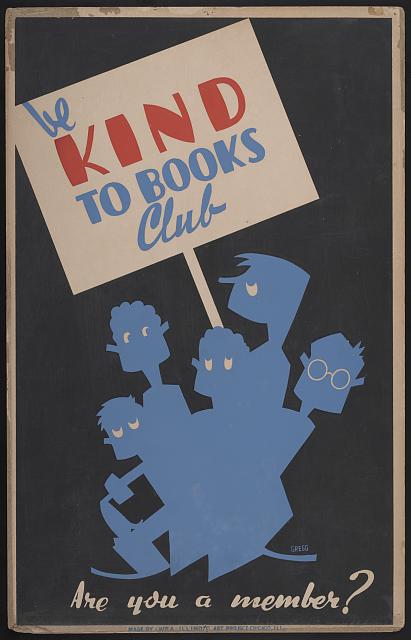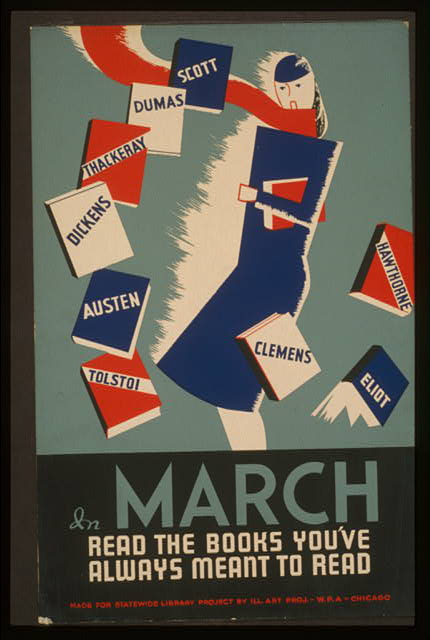April 10, 2013 at 1:29 pm
In view of CC202's intellectual dabbling in Jane Austen's works, the Core presents an article that argues Emma is in certain ways better than Persuasion. Here is an extract:
Published posthumously, it [Persuasion] has an almost skeletal feel, like an outline in which only the most salient points about each character are noted, as if Austen didn’t have time to “cover them with flesh.”
...
I have a theory: I suspect that some readers prize Persuasion because it is superficially more “serious” than Austen’s other novels.
...
Perhaps these readers hold up Persuasion, with its older, sadder protagonist, as a counterargument to the charge of frivolity. But Persuasion lacks not only the comic sparkle of Austen’s other novels. It also lacks, relatively speaking, the fineness of observation and the psychological nuance that is enough to make any book—even the fairy-tale-like love story of a teenage girl and a wealthy man—a great one.
...
Admirers make much of Austen’s deadpan tone, her wit, and her irony, and rightly so. But hers isn’t irony for irony’s sake: Austen’s portraits of people and their milieus are animated not by satirical malice or mere eagerness to entertain but by a sense of moral urgency. With a philosophical eye, she sees through fuss and finery and self-justification. She gives us a cast of characters and then zeroes in, showing us who and what is admirable, who is flawed but forgivable, who is risible and who is truly vile. Delivered economically, her judgments are not only clever but perspicacious, humane, and, for the most part, convincing. Her real subject is not the love lives of barely post-adolescent girls, but human nature and society. Austen wrote stories that show us how we think.
...
Take Emma, in which Austen is at the height of her powers as both an artist and analyst of human beings. The novel has very few obvious signifiers of “seriousness".
...
Emma is the most perfect of Austen’s novels in part because the engine of its plot doesn’t run on a single moral lesson—the twin evils of pride and prejudice, the desirability of being sometimes persuadable rather than invariably headstrong, the advantageousness of sense over sensibility. It preaches humility, but it does so humbly.
For the full article, visit slate.me/YkV89S
By mdimov
|
Posted in Academics, Core Authors, Curriculum, Great Personalities, Great Questions
|
Tagged better, Emma, Jane Austen, novel, Persuasion, posthumous, skeleton, structure, style, text
|
April 5, 2013 at 11:45 am
Relating to CC102's study of Dante's Divine Comedy are illustrations made by Salvador Dali for Inferno. Here is a sample:
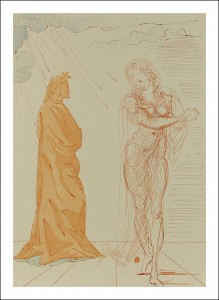
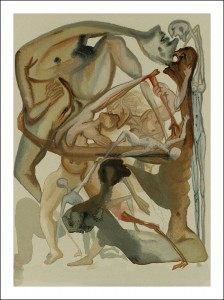
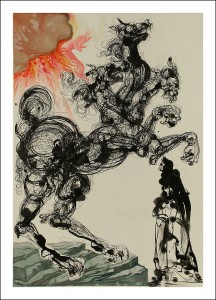
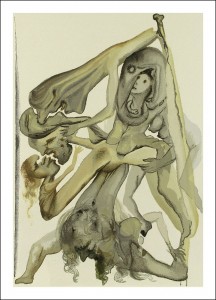

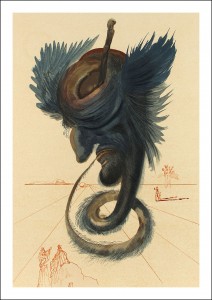
For the full set of images, visit bit.ly/14TfLgu.
To view Dali’s illustrations for Purgatorio, visit bit.ly/17H3fQT, and for Paradiso, visit bit.ly/17vAa9P.
By mdimov
|
Posted in Academics, Art, Core Authors, Great Ideas, Great Personalities
|
Tagged book, CC102, dante, Divine Comedy, drawing, illustration, inferno, painting, picture, Salvador Dali
|
April 2, 2013 at 12:51 pm
In her post for Poetry Foundation, Laura Sims discusses the strange inspiration that waiting rooms can bring, and how they can be "conducive to poetry". Here is an extract:
The speaker of Elizabeth Bishop’s 'In the Waiting Room' has a famously crucial moment in a doctor’s office, too. She looks around at all the adults, all the human beings surrounding her, and sees only body parts, or items of clothing: knees, boots, and “pairs of hands / lying under the lamps.” It’s like a scene from a horror movie...Even as she’s awakening to her self, her I-ness, she’s also awakening to her them-ness, and it is terrible, necessary, and awesome.
But ultimately unsustainable. The parted veil must fall back into place.
Then I was back in it.
The War was on. Outside,
in Worcester, Massachussetts,
were night and slush and cold,
and it was still the fifth
of February, 1918.
For the full article, visit bit.ly/YZc81c
By mdimov
|
Posted in Academics, Art, Great Ideas, Great Questions
|
Tagged appointment, doctor, idle, inspiration, medicine, mortality, poetry, procrastinate, room, time, waiting
|
April 2, 2013 at 12:06 pm
Relating to CC105's study of astronomy is an article from The Guardian titled 'The Cosmic Gallery - In Pictures'. It gives beautiful depictions and descriptions of some of our galaxy's landmarks. Here is a sample:

The Heart of The Milky Way - Some 26,000 light years and countless intervening clouds of stars, gas and dust separate Earth from the core of our galaxy. In visible light it is totally hidden from our view behind the bright star clouds of Sagittarius., but orbiting telescopes that observe at other wavelengths can pierce the veil to reveal a strange landscape of twisted dust clouds, violent stars and superhot gas. Right of centre, a blaze of blue and white reveals a huge cluster of heavyweight stars swimming in a sea of hot gas: they mark the exact centre of the Milky Way, orbiting around an invisible supermassive black hole with the mass of 4 million Suns.

The Dunes of Mars - Complex sand patterns ripple across a crater floor in the Noachis Terra region of the Martian southern hemisphere. While the northern regions of Mars are dominated by low rolling plains, the southern hemisphere is more chaotic and heavily cratered. Windblown sand accumulates in the floor of these craters, where it is frequently blown into beautiful dune patterns, some of which are unknown from Earth's deserts and probably owe their unique forms to the tiny size of Martian sand grains.
For the full article, visit bit.ly/10vKZ62.
By mdimov
|
Posted in Academics, Art, Curriculum, Great Ideas, Great Photograph
|
Tagged astronomy, CC105, galaxy, gallery, image, nebula, picture, space, stars
|
April 2, 2013 at 11:39 am
On a lighter note, let us explore pronunciation. In his article for The Spectator, Mark Mason discusses the strange but interesting book, How To Pronounce It, written by Alan S.C. Ross in 1970. Here is a sample:
It took me quite a while to be sure that the book isn’t a spoof after all. ‘Gone’, we’re told, should rhyme with ‘born’, NOT with ‘on’. ‘Lather’ must be pronounced to rhyme with ‘gather’, and NOT (Ross’s capitals) with ‘father’. ‘This second, non-U pronunciation,’ he fumes, ‘is almost universal in the television advertisements for soap powders’.
The reason it’s so amusing in 2013, yet seemed so sensible in 1970, is that back then if you set something down in a book you set it in stone. Books were written by clever people who knew things, and what’s more had lots of initials to remind you that they knew things. They legislated on language for the rest of us, piteous little oiks that we were. There was right and there was wrong, and woe betide you if you didn’t know the difference. Today, on the other hand, social media is inventing new words faster than even an e-book could cope with, never mind a conventional one.
For the full article, visit bit.ly/16jgkwa.
By mdimov
|
Posted in Academics, Friday Fun, Great Questions, Tuesday Humor
|
Tagged Alan S.C. Ross, pronounce, pronunciation, review, rhyme, The Spectator, word
|

